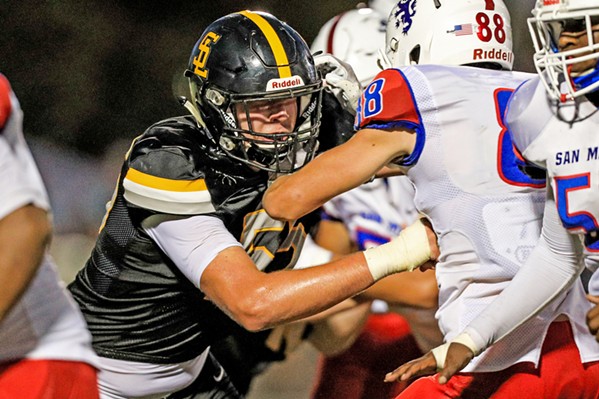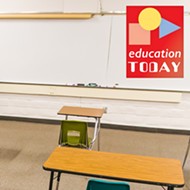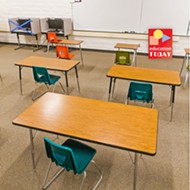Rules of the game: Delays in fall sports could make it harder for high school athletes hoping to play in college
By Kasey Bubnash[{
"name": "Ad - Medium Rectangle CC01 - 300x250",
"id": "AdMediumRectangleCC01300x250",
"class": "inlineCenter",
"insertPoint": "8",
"component": "2963441",
"requiredCountToDisplay": "12"
},{
"name": "Ad - Medium Rectangle LC01 - 300x250",
"id": "AdMediumRectangleCC01300x250",
"class": "inlineCenter",
"insertPoint": "18",
"component": "2963441",
"requiredCountToDisplay": "22"
},{
"name": "Ad - Medium Rectangle LC09 - 300x250",
"id": "AdMediumRectangleLC09300x250",
"class": "inlineCenter",
"insertPoint": "28",
"component": "3252660",
"requiredCountToDisplay": "32"
}]
Kelli Cole considers her son to be one of the lucky ones.
An incoming senior at San Luis Obispo High School, her son, Thomas Cole, stands 6-foot-7 and weighs 275 pounds. His is the ideal body type for someone who loves basketball and football and aspires to go pro, and his strength, height, and dedication gave him an advantage early on in high school.
As a junior, Thomas had a strong season as SLO High School's left tackle, and ended the school year with hours of film to send off to college recruiters and multiple offers from college football teams. Although Kelli said her son's college plans are still somewhat uncertain because of the COVID-19 pandemic, Thomas verbally committed to play for UCLA in June and he hopes to graduate from high school early this year.
"So he's in a super good position," Kelli told New Times.
But as secretary of the SLO High School Tiger Athletic Booster Club, Kelli knows better than anyone that this isn't the case for most high school athletes. With cases of COVID-19 surging throughout SLO County, most local school districts are planning to continue distance learning in the fall. In-person collegiate recruiting is suspended, and fall sports are being delayed, which could leave high school athletes—many of whom already had their last spring seasons interrupted and summer camps canceled—with difficult choices to make come winter.
Altogether, Kelli said the COVID-19 related closures, cancellations, and delays have left a lot of kids without all the usual opportunities to show off their skills to college recruiters.
Even the lucky ones aren't completely safe. Thomas had to cancel seven unofficial college visits this summer, and may have to choose between playing football or basketball—sports that would normally occur at different times of the year—his senior year. And Kelli said delays in college sports seasons could impact whether incoming freshmen even get the spots they were promised.
Of course, she said, everyone is just doing everything possible to stay safe in this uncertain time.
"I just feel so bad for a lot of kids who didn't have super good junior film," Kelli said.
In a statement released on July 20, the California Interscholastic Federation (CIF), the state's governing body for high school sports, announced its modified schedule for the 2020-21 school year. Sports like cross country, volleyball, water polo, and football that normally start in the fall are instead slated to run from December through March 2021. Badminton, soccer, and tennis will start up in late February of next year, and after that, pretty much everything else starts in mid-March.
Most schools in SLO County are still trying to figure out how to deal with all the potential for overlap—in practices and games for multi-sport athletes and coaches, and in scheduling for field and gym space.
At SLO High School, Athletic Director Marci Beddall said the plan for the coming school year in sports, as it stands now, is "very fluid."
Under the new CIF schedule, SLO High has about 14 different teams, each with more teams at every grade level, that will have to schedule practices and games in the spring using just six fields. And that puts SLO High in a better position than most schools, she said.
On top of that, several of SLO High's coaches lead multiple sports that will overlap for the first time ever in 2020-21. The same goes for student athletes, and while Beddall said it's not clear yet whether coaches will be allowed to participate in multiple sports, students will be able to make those decisions for themselves. If students think they can logistically and mentally handle playing two sports at once, Beddall said they'll be permitted to do so.
"Our goal is to make sure that all of our student athletes get to play whatever sports they want to play," she said.
It's all going to require some serious flexibility from everyone, but Beddall said she's confident that with a little teamwork, SLO High can make it work.
"Honestly," she said, "at this point all of our coaches and all of our athletes just want some kind of season as long as it's safe."
Still, there are questions about how all this will impact college recruiting and the students hoping that sports scholarships will pave their way to higher education.
College recruiters use a lot of different methods—viewing game and practice film, hosting summer camps, and keeping an eye on club sports—to scout high school talent, and typically attending high school games is a big part of that. Beddall said college coaches will likely have to lean more heavily on film to make their choices this time around. For kids who might not have enough film to send out yet, Beddall's hoping that colleges will host more sports combines later in the year, events where athletes can go to get evaluated.
But for now, in-person recruiting in any form is not allowed. In March, the National Collegiate Athletic Association (NCAA) suspended in-person recruiting and encouraged colleges to cancel all official and unofficial visits. The suspension lasts until Aug. 31, but it will likely be extended.
Despite the challenges, college coaches are still in constant contact with prospective student-athletes and their families via phone and email, according to Don Oberhelman, director of athletics at Cal Poly. Recruiting at high school and club games offer coaches important evaluation data, but Oberhelman said the delays and cancellations of seasons shouldn't have too much of an impact on which high school athletes are chosen.
"In most cases," Oberhelman wrote in an email to New Times, "coaches know earlier than a senior year as to a prospective student-athletes collegiate capabilities, so the scholarship and roster availability will still be there."
The biggest concern for colleges everywhere, Oberhelman said, is how they'll be able to fund the usual sports scholarships while facing "catastrophic losses in revenue" from canceled college football and basketball games.
NCAA athletics departments collectively generated $10.3 billion in 2018 alone, according to the NCAA, revenue that goes in part to financial aid for student athletes. Schools nationally spent $3.5 billion on such scholarships in 2018, according to data collected by the NCAA.
With the Big West Conference's July 29 decision to delay fall sports until at least January 2021, Oberhelman said questions about how and if the same number of scholarships will be offered at Cal Poly remain unanswered. Δ
Reach New Times staff writers through the editor at [email protected].
Latest in News
Readers also liked…
-

Coast Unified teachers upset over new position's salary and qualifications
Oct 20, 2022 -

SLO police identify alleged driver who hit and killed couple
Dec 22, 2022 -

When the levee breaks: Oceano residents, county officials walk a tightrope of regulations to manage Arroyo Grande Creek, which some say led to the levee's failure in January
May 18, 2023













